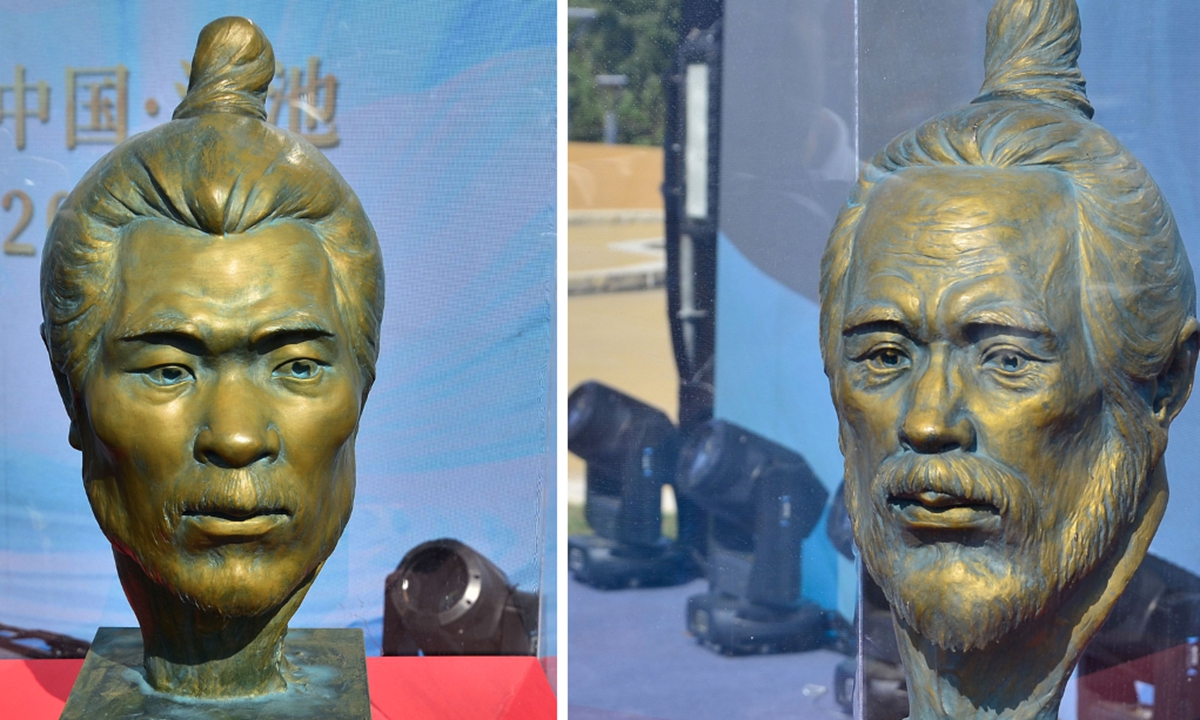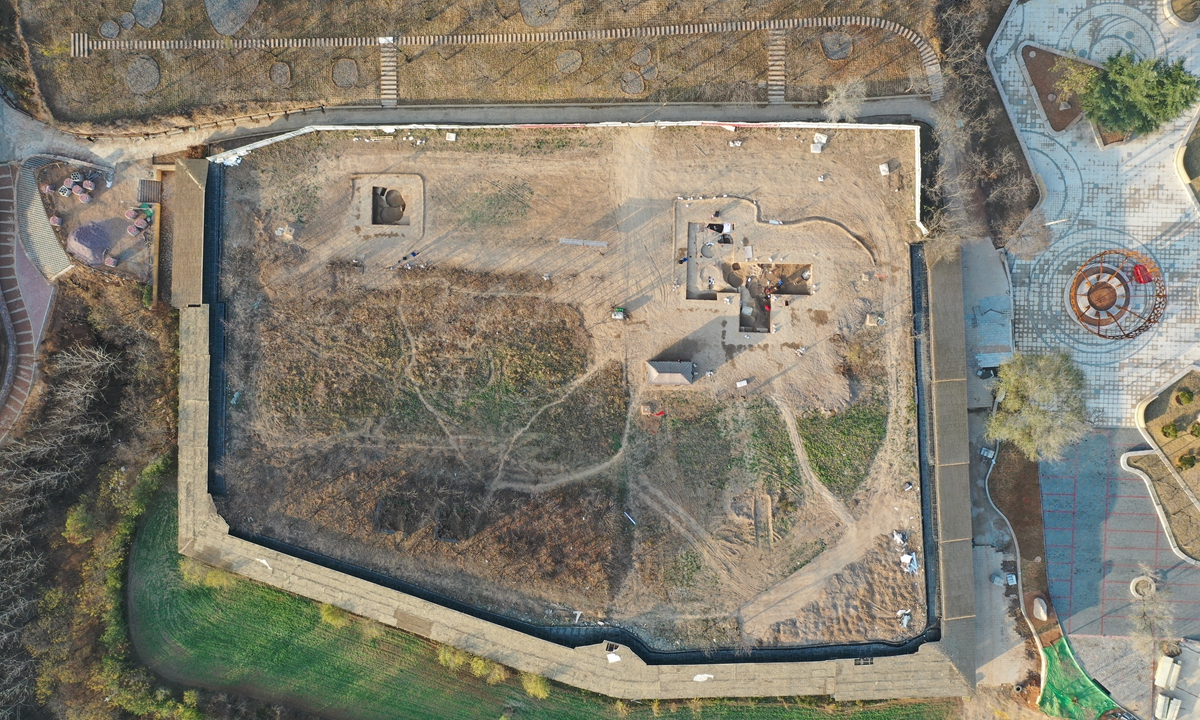
Reconstructions of two men who are believed to have lived during the Yangshao Culture period 5,600 years ago (left) and the Longshan Culture period roughly 4,000 years ago Photos: VCG
Around 5,000 to 7,000 years ago, the Yangshao people built settlements on river valley terraces along the Yellow River, engaging in horticulture, animal husbandry, hunting, pottery-making, and other activities. For centuries, many Chinese have been curious about the appearance of these ancestors, especially those from the early Neolithic period. Now, we finally have an answer.
Through technological analysis of human bones unearthed during the fourth archaeological excavation at Yangshao Village site, the facial features of two ancestors were reconstructed for the first time, the Henan Provincial Institute of Cultural Relics and Archaeology announced recently.
One man, believed to have lived around 5,600 years ago during the Yangshao Culture period, was estimated to be approximately 40 years old. The other, from the Longshan Culture period roughly 4,000 years ago, was around 50 years old. The Yangshao Culture and Longshan Culture represent different periods of Neolithic culture in the Yellow River area.
This significant discovery brings us closer to understanding the early inhabitants of China's Yellow River Basin, a region widely regarded as the cradle of the Chinese civilization.

A bird's-eye view of the fourth archaeological excavation site at Yangshao Village Photo: Courtesy of Henan Provincial Institute of Cultural Relics and Archaeology
Tech aid in reconstructionThe Yangshao Village site is located in Mianchi county, Central China's Henan Province. The first excavation of the site kicked off in 1921. The name of China's first-known archaeological culture, the Yangshao Culture, was also derived from this site.
In August 2020, the fourth phase of the archaeological excavation of the Yangshao Village site was launched.
"During the fourth excavation, more than 10 human remains from the Yangshao and Longshan culture periods were discovered. We selected two skulls that were relatively well-preserved and largely intact for facial reconstruction to increase the accuracy," Li Shiwei, head of the fourth archaeological excavation at the Yangshao Village site, told the Global Times.
The facial reconstruction project was initiated in 2023, with the Henan institute collaborating with various organizations to bring the ancient faces to life.
The research team employed a variety of advanced techniques, including 3D scanning, 3D printing, carbon-14 dating, and ancient DNA studies, fully utilizing craniofacial reconstruction technology to recreate the faces of ancient individuals from the Yangshao Village site.
According to Li, the biggest challenges during the reconstruction process were effectively combining multiple disciplines and technologies, as well as extracting and studying ancient DNA.
Given the absence of written or visual records from these ancient people, to obtain precise data, the team collected over 4.01 million points on the skulls of the Yangshao ancestors, and then applied muscle tissue from genetically similar populations and used genetic analysis to predict skin and hair color. The accuracy of the reconstruction is around 90 percent, according to Li.
"From the current reconstruction results, the physical characteristics of the Yangshao ancestors are largely consistent with modern populations," Li said.
"The ancient DNA research from the Yangshao Village site can help understand the genetic history of prehistoric populations in the Yellow River Basin, providing significant insights into the formation and development of the Chinese nation."
Significant discoveries
Originating around the middle reaches of the Yellow River, the Yangshao Culture is considered an important stream of the Chinese civilization and is widely known for its advanced pottery-making technology.
In 1921, the first excavation at the Yangshao Village site marked the birth of modern Chinese archaeology. In 1951 and 1980, China launched the second and third excavations at the site.
To commemorate the centenary of the birth of Chinese archaeology and the discovery of the Yangshao Culture, the fourth archaeological excavation at the Yangshao Village site was launched on August 22, 2020.
The excavation covers an area of 600 square meters, yielding rich findings. One of the notable findings is a large residential building from the late Yangshao Culture period, measuring more than 120 square meters, which was discovered in the southern living area of the site during the excavation.
This is the first time that large house ruins have been discovered since the excavation of the Yangshao Village site in 1921. The findings can provide new materials for studying the types, shapes, and building techniques of houses constructed during the Yangshao Culture period.
Archaeologists also unearthed four artificial trenches and a large number of cultural relics at the site, including a jade tomahawk that symbolizes military power.
The fourth excavation also unearthed a large number of artifacts, including pottery, jade, stone tools, bone implements, and ivory products. Additionally, archaeologists also found grayish-blue flooring resembling concrete and red-brown walls made of straw and mud.
Simultaneously, multidisciplinary research has yielded a series of findings. For example, traces of silk were detected in soil samples from the soils covering the human remains dating back to the Yangshao and Longshan cultures, and evidence of fermented grain alcohol was found in residues from a vessel from the Yangshao Culture period.
Throughout the excavation process, a cutting-edge field archaeological management system was fully utilized, allowing for the digitization of all excavation data, photos, and videos, facilitating permanent preservation and later analysis and research.
The fourth excavation at the Yangshao Village site has concluded, and the team is conducting related further work. "Looking ahead, the archaeological team plans to use modern technology to gather even more rich archaeological information, deepening the understanding of the Yangshao Culture and promoting the application and utilization of research findings," Li said.





